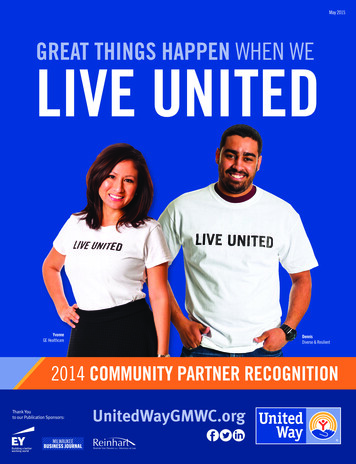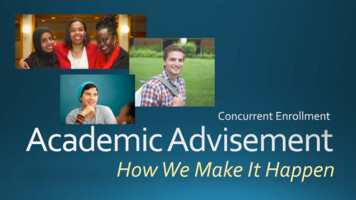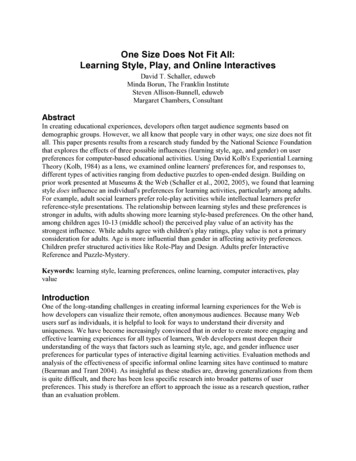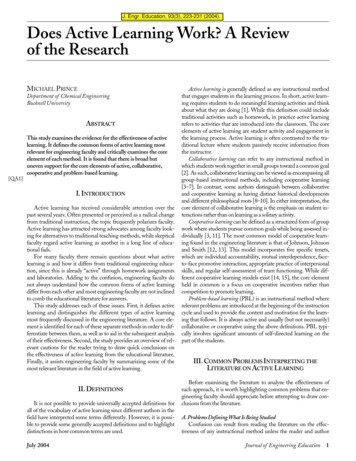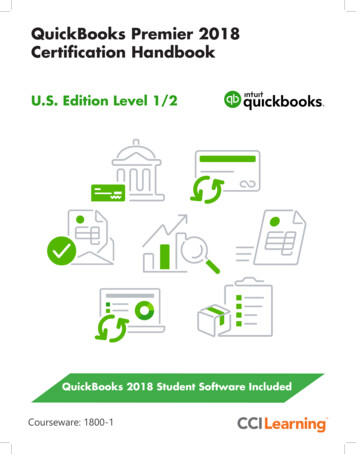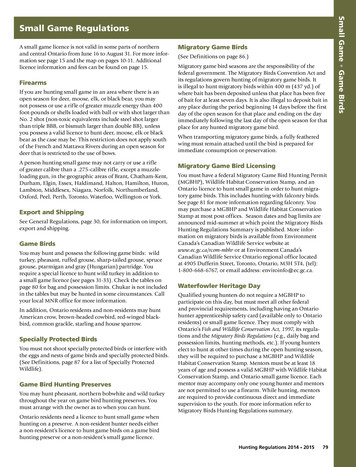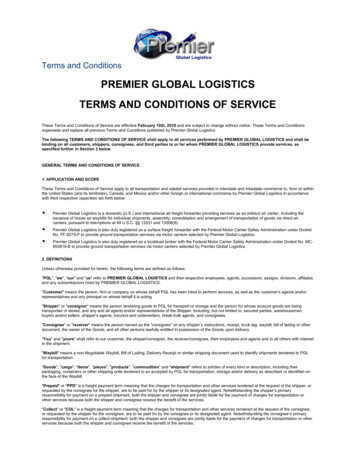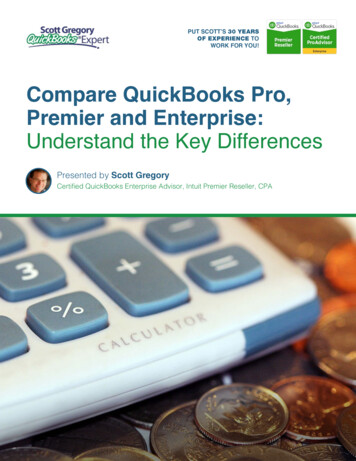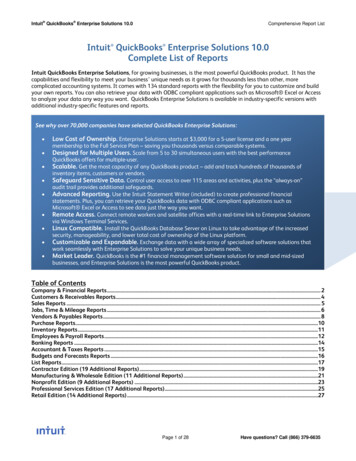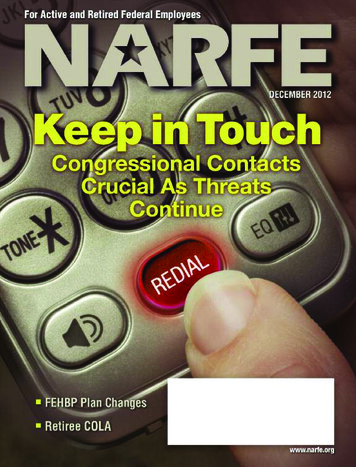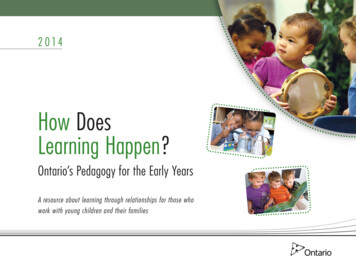
Transcription
2 014How DoesLearning Happen?Ontario’s Pedagogy for the Early YearsA resource about learning through relationships for those whowork with young children and their families
The Ontario Public Service endeavours to demonstrate leadership with respect to accessibility in Ontario. Our goal is toensure that Ontario government services, products, and facilities are accessible to all our employees and to all membersof the public we serve. This document, or the information that it contains, is available, on request, in alternative formats.Please forward all requests for alternative formats to ServiceOntario at 1-800-668-9938 (TTY: 1-800-268-7095).13-162 ISBN 978-1-4606-3838-5 (Print) ISBN 978-1-4606-3839-2 (PDF) Queen’s Printer for Ontario, 2014
ContentsAcknowledgements3A Vision for Ontario’s Early Years4Introduction5An Understanding of Children, Families, and EducatorsThe Four Foundations of How Does Learning Happen?67ELECT and a Brief History ofEarly Learning in Ontario9ELECT PrinciplesBuilding from ELECT to How Does Learning Happen?Research, Theory, and PracticeWhat’s Most Important?10101111How to Use This Resource Guide12Goals for ChildrenExpectations for ProgramsQuestions for Reflection121313Une publication équivalente est disponible en français sous le titre suivant :Comment apprend-on? – Pédagogie de l’Ontario pour la petite enfance.This publication is also available on the Ministry of Education’s website, at www.ontario.ca/edu.Supporting a Continuum of Learning14Early Years CurriculumEarly Years PedagogyThe ChildUnderstanding Child DevelopmentUnderstanding Children from Different PerspectivesThe FamilyThe CommunityThe EducatorCritical ReflectionCollaborative InquiryThe EnvironmentPedagogical Documentation151617171718191920202021Foundations for Learning23Belonging: Cultivating Authentic Relationshipsand ConnectionsOverviewGoals and ExpectationsQuestions for Reflection24242628
Well-Being: Nurturing Healthy Development and Well-BeingOverviewGoals and ExpectationsQuestions for ReflectionEngagement: Creating Contexts for Learning throughExploration, Play, and InquiryOverviewGoals and ExpectationsQuestions for Reflection2929323435353739Expression: Fostering Communication and Expressionin All FormsOverviewGoals and ExpectationsQuestions for Reflection41414345References46
AcknowledgementsHow Does Learning Happen? Ontario’s Pedagogy for the Early Yearsis the product of hundreds of conversations.The Ministry of Education would like to sincerely thank themany voices that have contributed to this document. Yourexperience, knowledge, wisdom, and passion have informed ourcollective thinking to shape this transformational document.Over the past two years, we have engaged with various partners,system leaders, experts, professionals, and practitioners from allsegments of the early years sector. Through individual dialogue,local focus groups, and various provincial forums, there weremany rich discussions and there will be many more to come.We look forward to continuing our conversations across theprovince as we explore together how learning happens.How Does Learning Happen? Ontario’s Pedagogy for the Early Years3
4How Does Learning Happen? Ontario’s Pedagogy for the Early YearsA Vision for Ontario’s Early YearsChildren’s early experiences last a lifetime.During our first years of life, the brain develops at an astoundingrate. Scientists now know this process is not just genetic but isdramatically influenced by our early experiences with people andour surroundings.1While a child’s principal sources for supportive relationshipsand learning experiences are at home, many Ontario childrenalso attend child care and child and family programs. Earlyyears programs play an important role in supporting children’slearning, development, health, and well-being. Evidence fromdiverse fields of study tells us that children grow in programswhere adults are caring and responsive. Children succeed inprograms that focus on active learning through exploration, play,and inquiry. Children thrive in programs where they and theirfamilies are valued as active participants and contributors.In January 2013, theOntario government releasedthe Ontario Early Years PolicyFramework, which articulates thefollowing vision for early years programs:“Ontario’s children and families are wellsupported by a system of responsive, high-quality, accessible,and increasingly integrated early years programs and services thatcontribute to healthy child development today and a stronger futuretomorrow.”2How Does Learning Happen? Ontario’s Pedagogy for the Early Years,2014 builds on this policy framework and is a key componentof Ontario’s vision for the early years. It demonstrates ourcommitment to strengthening the quality of early yearsprograms by ensuring these programs are centred on the childand the family.There is perhaps no relationship that holds greater responsibilityor reward than the relationships we develop with children.As educators, as family members, as policy makers, or asadministrators, we all know that the stronger our partnershipsand the deeper and more valuable our connections, the greaterthe benefit. It’s an investment that allows us all to grow.1. National Scientific Council on the Developing Child, n.d.2. Ministry of Education, Ontario, 2013, p. 2.
IntroductionHow does learning happen?What relationships and environments support it? Whatactions support children’s learning? What does theoryand research tell us? These are questions with constantlyevolving and shifting answers. While there are generalprinciples and knowledge we can refer to, we must alwaysthink, feel, and act in ways that reflect the environment,the circumstances, and most importantly the children,families, and colleagues we have before us in every uniquesituation. As we question, research, reflect, respond, andco-construct our understanding of the world around uswith children and families, we gain new perspectives andnew and more complex questions arise. This document isnot so much about providing all the answers, but rather isintended to provoke questions – for it is in exploring ourquestions that learning happens.Pedagogy is “the understandingof how learning takes placeand the philosophy and practicethat support that understanding oflearning”.3 Curriculum (the content oflearning) and pedagogy (how learning happens) inearly years settings are shaped by views about children, therole of educators and families, and relationships among them.This pedagogical document, How Does Learning Happen?, helpseducators focus on these interrelationships in the context of earlyyears environments.We have used the term “educator” throughout thisdocument to refer to all who work with children andfamilies in early years programs (e.g., centre- and homebased child care, child and family programs, before andafter school programs).How Does Learning Happen? Ontario’s Pedagogy for the Early Yearsis a professional learning resource guide about learning throughrelationships for those working with young children and families.It is intended to support pedagogy and curriculum/programdevelopment in early years programs.3. Early Learning for Every Child Today: A Framework for Ontario Early Childhood Settings (Ministry of Education,Ontario, 2007), p. 90; hereafter cited as ELECT.How Does Learning Happen? Ontario’s Pedagogy for the Early Years5
6How Does Learning Happen? Ontario’s Pedagogy for the Early YearsHow Does Learning Happen? sets out a shared understanding ofchildren, families, and educators.Reflecting on these views about children, families, and educatorsin the context of the early years environment is a starting point fordeveloping programs and practices to support learning.An Understanding of Children, Families, andEducatorsSetting out and acting on a strong image of children, families,and educators has a profound impact on what happens in earlyyears settings.4 Reflecting on a shared understanding andworking towards greater consistency between what we say andwhat we do provides a means to strengthen and transform earlyyears programs across the province.Children are competent, capable of complex thinking,curious, and rich in potential. They grow up in familieswith diverse social, cultural, and linguistic perspectives.Every child should feel that he or she belongs, is avaluable contributor to his or her surroundings, anddeserves the opportunity to succeed. When we recognizechildren as capable and curious, we are more likely todeliver programs and services that value and build ontheir strengths and abilities.Figure 1. Learning and development happens within the context of relationships among children,families, educators, and their environments.4. Moss, 2010.
Families are composed of individuals who are competentand capable, curious, and rich in experience. Familieslove their children and want the best for them. Familiesare experts on their children. They are the first and mostpowerful influence on children’s learning, development,health, and well-being. Families bring diverse social,cultural, and linguistic perspectives. Families shouldfeel that they belong, are valuable contributors to theirchildren’s learning, and deserve to be engaged in ameaningful way.Educators are competent and capable, curious, and richin experience. They are knowledgeable, caring, reflective,and resourceful professionals. They bring diverse social,cultural, and linguistic perspectives. They collaboratewith others to create engaging environments andexperiences to foster children’s learning and development.Educators are lifelong learners. They take responsibilityfor their own learning and make decisions about waysto integrate knowledge from theory, research, their ownexperience, and their understanding of the individualchildren and families they work with. Every educatorshould feel he or she belongs, is a valuable contributor,and deserves the opportunity to engage in meaningfulwork.The Four Foundations of How Does LearningHappen?How Does Learning Happen? is organized around fourfoundational conditions that are important for children togrow and flourish: Belonging, Well-Being, Engagement, andExpression. These foundations, or ways of being, are a vision forall children’s future potential and a view of what they shouldexperience each and every day. These four foundations applyregardless of age, ability, culture, language, geography, or setting.They are aligned with the Kindergarten program. They areconditions that children naturally seek for themselves.Belonging refers to a sense of connectedness to others,an individual’s experiences of being valued, of formingrelationships with others and making contributions as partof a group, a community, the natural world. Well-being addresses the importance of physical and mentalhealth and wellness. It incorporates capacities such as selfcare, sense of self, and self-regulation skills. Engagement suggests a state of being involved and focused.When children are able to explore the world around themwith their natural curiosity and exuberance, they are fullyengaged. Through this type of play and inquiry, theydevelop skills such as problem solving, creative thinking, andinnovating, which are essential for learning and success inschool and beyond. How Does Learning Happen? Ontario’s Pedagogy for the Early Years7
8How Does Learning Happen? Ontario’s Pedagogy for the Early Years Expression or communication (to be heard, as well as tolisten) may take many different forms. Through their bodies,words, and use of materials, children develop capacities forincreasingly complex communication. Opportunities toexplore materials support creativity, problem solving, andmathematical behaviours. Language-rich environmentssupport growing communication skills, which arefoundational for literacy.A focus on these foundations throughout all aspects of early yearsprograms ensures optimal learning and healthy development.While this pedagogical document is built on the abovefoundations, the groundwork for How Does Learning Happen?is the 2007 publication Early Learning for Every Child Today:A Framework for Ontario Early Childhood Settings, commonlyreferred to as ELECT or the Early Learning Framework.Figure 2. The four foundations ensure optimal learning and development. These foundations inform thegoals for children and expectations for programs.
ELECT and a Brief History ofEarly Learning in OntarioAll educators who deliver high-quality early years programsknow that you are never done.The Ontario government launched Best Start in 2005 alongwith the Best Start Expert Panel on Early Learning. The panel’smandate was to create an early learning framework that wouldhelp to improve quality and consistency in early childhoodsettings across Ontario.In January 2007, the government published Early Learning forEvery Child Today: A Framework for Ontario Early ChildhoodSettings. This early learning framework, referred to as ELECTthroughout this document, sets out six principles to guidepractice in early years settings. It also provides a continuum ofdevelopment for children from birth to age eight.ELECT is recognized as a foundational document in theearly years sector. It provides a shared language and commonunderstanding of children’s learning and development forearly years professionals as they work together in various earlychildhood settings. The principles of ELECT have informedprovincial child care policy, such as the Ontario Early YearsPolicy Framework, as well as pan-Canadian early learninginitiatives such as the Statementon Play of the Council of Ministers ofEducation, Canada. ELECT principles arealso embedded in the program document used inOntario’s innovative Kindergarten program.The Best Start Expert Panel on Early Learning based theprinciples in ELECT on their professional expertise, as well asan extensive review of Canadian and international research aboutearly childhood development and learning. These principles haveprovided a starting point for reflection and deeper investigation.Over the past several years, ELECT has had a significantimpact. Many child care operators, child and family programs,municipalities, postsecondary institutions, and otherorganizations have integrated elements of ELECT into theirprograms, training, and quality improvement strategies.How Does Learning Happen? Ontario’s Pedagogy for the Early Years9
10How Does Learning Happen? Ontario’s Pedagogy for the Early YearsELECT Principles5Principle 1: Positive experiences in early childhoodset the foundation for lifelong learning, behaviour,health, and well-being.Principle 2: Partnerships with families andcommunities are essential.Principle 3: Respect for diversity, equity, andinclusion is vital.Principle 4: An intentional, planned programsupports learning.Building from ELECT to How Does LearningHappen?Now, seven years after the publication of ELECT, thispedagogical document, How Does Learning Happen?, has beencreated to help educators build on their foundational knowledgeof the early years. This resource guide represents our evolvingunderstanding of children, pedagogy (how learning happens), andthe role of educators in supporting learning in the early years.It is grounded in new research and leading-edge practice fromaround the world. It incorporates what we have learned fromELECT and how it has been applied in programs and practiceacross the province. Rather than considering the principles ofELECT as separate elements, How Does Learning Happen? helpsus think about how the principles work together.Principle 5: Play and inquiry are learning approachesthat capitalize on children’s natural curiosity andexuberance.Principle 6: Knowledgeable, responsive, andreflective educators are essential.Figure 3. Building from a foundational knowledge about children and moving towards newunderstandings about pedagogy are supported by an ongoing practice of critical reflection and learning.5. ELECT, pp. 7–20.
Research, Theory, and PracticeDifferent schools of thought – from Dewey to Vygotsky,Mustard to Malaguzzi6 – have shaped educators’ approachesand understanding of children, families, and early learning anddevelopment.Neuroscience, developmental and social psychology, economics,medical research, and education and early childhood theoryand studies have all added to our knowledge of the early years.Over the past decade research across these disciplines gives us adramatic and consistent story. High-quality early childhood settingsare associated with immediate and long-term positive outcomes forchildren. Studies show that children who attend high-quality earlychildhood programs where they experience warm, supportiverelationships are happier, less anxious, and more motivated tolearn than children who do not.7What’s Most Important?Recurring themes from research, theory, and practicesuggest that high-quality early childhood programs: establish positive, responsive relationships withchildren and their families;value children as individuals and as active andcompetent contributors with their own interests andpoints of view;recognize the connection between emotional wellbeing and social and cognitive development and theimportance of focusing on these areas holistically;provide environments and experiences for children toexplore ideas, investigate their theories, and interactwith others in play;engage with families and support each child within thecontext of his or her family, recognizing that family andchild well-being are inextricably linked;provide ongoing opportunities for educators toengage in critical reflection and discussion with othersabout pedagogy and practice to support continuousprofessional learning and growth.6. References and additional resources are available on the Ministry of Education website, at www.ontario.ca/edu.7. Shanker, 2013.How Does Learning Happen? Ontario’s Pedagogy for the Early Years11
12How Does Learning Happen? Ontario’s Pedagogy for the Early YearsHow to Use This Resource GuideHow Does Learning Happen? is for those who work with andcare for young children (from birth to 8 years of age) in childcare and child and family programs. It may also serve as auseful resource for those working with children in othercontexts. This resource guide is intended to inspire educatorsand administrators in early years settings and to ignite criticalreflection and discussion. Incorporating a shared understandingof the roles of the educator, child, and family, it provides goalsfor children and expectations for programs in a chart format.The examples are by no means exhaustive but rather are intendedas a starting point for thinking about the types of environments,experiences, and interactions that support each goal and programexpectation. This pedagogical document also includes questionsfor reflection – a section that challenges educators andadministrators to discuss and reflect on their taken-for-grantedbeliefs and practices and to take on the role of researchers,applying new ideas from theory and research to their existingknowledge.Goals for ChildrenGoals for children’s learning, development, health, and wellbeing are integral to all aspects of early years programs, frompolicies and procedures to environments, experiences, andinteractions. Groundedin a view of the child ascompetent and capable andorganized around the foundations ofbelonging, well-being, engagement,and expression, the goals will help educatorsand administrators remain focused on children firstand foremost throughout all elements of the program. The goalsare not intended to be used as a checklist of tasks to be completedor benchmarks to be achieved. They are intended to be used byeducators in planning and creating environments, experiences,and contexts for children’s learning and development acrossall domains. They are also intended to guide the process ofobserving, documenting, studying, and discussing children’sexperiences with families.Every child has a sense of belonging when he or she isconnected to others and contributes to their world. Every child is developing a sense of self, health, andwell-being. Every child is an active and engaged learner whoexplores the world with body, mind, and senses. Every child is a capable communicator who expresseshimself or herself in many ways.
Expectations for ProgramsQuestions for ReflectionThe expectations for programs align with the goals forchildren. They provide concrete ideas about how educators,administrators, families, and communities can work togethertowards the goals for children’s learning, development, health,and well-being. They are not an exhaustive list but are meant toprovide a starting point for educators as they work towards thegoals for children. The expectations for programs:The questions support critical reflection and provide a means fordiscussing, interpreting, investigating, and acting on the goals forchildren. Thoughtful questioning and challenging of the statusquo on an ongoing basis can help transform programs and bringout the best in children, families, and educators. There are manyways to engage in critical reflection, for example:provide pedagogical direction and examples educators can referto as they think about and plan how to act on the goals for children; help educators become researchers and co-learners withchildren, parents, caregivers, and colleagues – learning aboutchildren, with children, and from children; help educators focus on building and maintainingrelationships and supporting connections among themselves,children, families, and the early years environment. The expectations for programs provide pedagogical direction foreducators as they:cultivate authentic, caring relationships and connectionsto create a sense of belonging among and betweenchildren, adults, and the world around them; nurture children’s healthy development and supporttheir growing sense of self; provide environments and experiences to engagechildren in active, creative, and meaningful exploration,play, and inquiry; foster communication and expression in all forms. Administrators, boards, parents, and educators may focus onseveral of the questions for discussion as they consider thepolicies and procedures of their program. Educator teams may choose a particular question toinvestigate over a period of time (and also include families intheir inquiry). A group of educators from several programs may study theirpractice and share their experiences in relation to one of thegoals for children. Individuals may incorporate various questions into personaldaily reflections at the beginning and end of each day. These questions are a starting point. Educators and administratorsare encouraged to consider additional questions that emerge fromthe goals and expectations during daily practice.“By involving ourselves in a constant inquiry into what we believe we will be on a journey of getting to be better and better as teachers allthe time.” 88. Callaghan, 2011, Early Learning Framework website, Principle 6: What the experts say.How Does Learning Happen? Ontario’s Pedagogy for the Early Years13
14How Does Learning Happen? Ontario’s Pedagogy for the Early YearsSupporting a Continuum of LearningPedagogical approaches and practices that work for young childrenare similar to strategies that work for learners of all ages, frominfancy to adulthood. A common view of children as competent andcapable, a shared understanding of the foundations for learningand development, and coherence across pedagogical approaches leadto more seamless programsfor children, families, and alllearners along a continuumof learning and development.This vision is illustrated below.Figure 4. Pedagogical approaches tosupport the key foundations for learningare common across settings and ages fora continuum of learning.
Early Years CurriculumEarly years curriculum frameworks have become a priority innearly all developed countries. A common framework has manybenefits and contributes to higher quality early years experiencesand outcomes. According to the international Organisationfor Economic Co-operation and Development, a curriculumframework:establishes a common understanding of good practice acrossdifferent settings; provides pedagogical direction for educators; informs and includes families in what and how their childrenare learning and developing; supports increased continuity for children as they transitionacross settings.9childhood education field.11 It is an expectation for all registeredearly childhood educators in Ontario.12The focus is not on teaching a body of knowledge or apredetermined set of topics. Nor is it centred on children’sachievement of a specific skill set. In the early years, programsare most effective when the content of learning is focused onsupporting the development of strategies, dispositions, and skillsfor lifelong learning through play and inquiry. Curriculum in early years settings is very different from thatused in formal school contexts. As defined in ELECT, earlyyears curriculum is the sum total of experiences, activities, andevents that occur within an inclusive environment designedto foster children’s well-being, learning, and development andensure meaningful participation for every child. It begins with aninformed understanding of what children are capable of learningand how they learn effectively; it sets out goals for children’slearning and development, health, and well-being; and it providesdirection for educators.10 This is the basis of training in the early9. Organisation for Economic Co-operation and Development (OECD), 2012.10. ELECT, p. 66.Through play and inquiry, young children practise ways oflearning and interacting with the world around them that theywill apply throughout their lives. Problem solving and criticalthinking, communication and collaboration, creativity andimagination, initiative and citizenship are all capacities vital forsuccess throughout school and beyond.13How Does Learning Happen? asks educators to be attuned towhat children know, what they wonder about, and their workingtheories about the world around them. Educators engagewith, observe, and listen to children. They discuss with othereducators, as well as with children and families and caregivers,the possibilities for children’s further exploration in increasinglycomplex ways. All are co-learners, constructing knowledgetogether.11. Ministry of Training, Colleges and Universities, Ontario, December 2012, p. 8; College of Early ChildhoodEducators, 2011, p. 19.12. College of Early Childhood Educators, 2011.13. Fullan, 2013.How Does Learning Happen? Ontario’s Pedagogy for the Early Years15
16How Does Learning Happen? Ontario’s Pedagogy for the Early Years“In taking a negotiated learning approach, teachers movebeyond simply providing children with experiences. Theyprobe further, either by asking questions, or by engagingin discussion to discover why children are deeplyabsorbed in exploring a material, or they try to figure outwhat children are thinking as they touch, taste, examine,and explore [the world around them].”14Pedagogical approaches that nurture learning and developmentin the early years include: Early Years PedagogyPedagogy is defined as the understanding of how learninghappens and the philosophy and practice that support thatunderstanding of learning.15The term “pedagogy” may be unfamiliar to some in early yearssettings. Thinking about pedagogy provides a new way foreducators to consider their work. It helps educators to: establishing positive, responsive adult-child relationships;providing inclusive learning environments and experiencesthat encourage exploration, play, and inquiry;engaging as co-learners with children, families/caregivers, andothers;planning and creating environments as a “third teacher”;using pedagogical documentation as a means to value, discuss,and make learning visible;participating in ongoing reflective practice and collaborativeinquiry with others.16These same approaches that are effective for children are also keyelements of learning and engagement for families and those whowork with children; what is good pedagogy for children is alsogood pedagogy for adults.look more carefully at what they do each and every day; think about the why of their practice; understand more deeply how their actions have an impact onchildren and their families. 14. Fraser, 2012, p. 184.15. ELECT, p. 90.16. References and additional resources on pedagogical approaches are available on the Ministry of Educationwebsite, at www.ontario.ca/edu.
The ChildUnderstanding Child DevelopmentA solid understanding of child development is essential foreducators to apply the pedagogical approaches that are outlinedin this document. Child development provides a body ofknowledge that can help us to recognize and articulate children’sobserved behaviours and discuss their emerging skills withfamilies and others.When educators have an understanding of child development – ofwhat has come before and what may come next – they are able toprovide experiences that challenge children to stretch just beyondwhat they know and can do. As L.S. Vygotsky suggests, “goodlearning” happens through interactions where the adult canchallenge children and provoke learning at a level that is slightlyin advance of the child’s current capacities.17 Knowing what toexpect in typically developing children can also help educators torecognize when a child is experiencing challenges or when his orher needs are not being met.ELECT provides a resource, the continuum of development,that educators can use to understand the sequences ofdevelopment. It is not a lock-step, universal pattern that shouldbe achieved according to a specific timetable, nor is it intendedto be used as an assessment tool or checklist of tasks to becompleted.1817. Vygotsky, 1978.18. ELECT, p. 22.While child development is often categorized into separatedomains
How Does Learning Happen? Ontario’s Pedagogy for the Early Years . is a professional learning resource guide about learning through relationships for those working with young children and families. It is intended to support pedagogy and curriculum/program developmen

